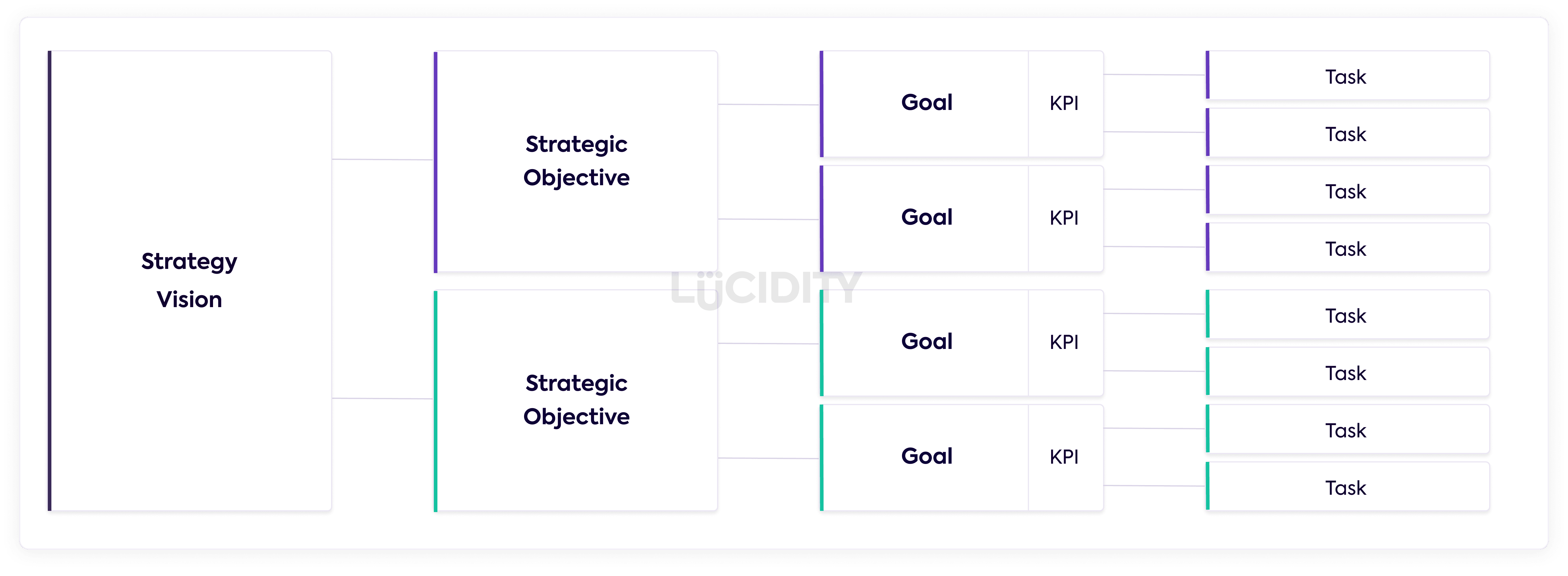If you’re reading this article you may have already accepted that not everyone in your company knows the strategy. In fact, if you’re like many businesses out there, the actual knowledge of a strategic plan within the business can be frighteningly low, with research showing only 28% of middle management and executives know their company’s strategy (source: MITSloan).
That leaves 72% of the very people who are tasked with executing that strategy not really knowing it. This is where many talented teams fail.
Regardless of if you are into strategy or not, the simple lack of team alignment will be holding you back or, worse still, could bring you to failure. If you don’t have this alignment and understanding of what you’re trying to achieve then everything is harder.
So, why is it the case that so many people simply don’t know about their company strategies? These are talented teams in great companies, there’s unlikely to be a general aversion to the strategy for that 72%. It comes down to the three common problems:
- Strategy is communicated badly
- People feel it doesn’t impact them
- It doesn’t relate to the day-to-day job
We know from our own research across hundreds of companies that strategy is sometimes only done once a year. We’ve all seen this sort of thing, a gathering off site where teambuilding games are conducted and discussion occurs, as if strategy is some annual event like a birthday.
Look, we get it. Strategy as a word has connotations that are nebulous, negative, boring – it’s associated with that hotel conference room from the off-site. But it really isn’t like that when done well. When done well it’s about empowering a team, aligning and focusing, and the collective talent succeeding in their goals. Strategy is just a catch-all term for working out what to do and everyone getting behind it…
But none of that can happen if people don’t even know what the strategy is!
Communication
The natural reaction to solving this problem is to communicate out about strategy more often and, of course, that is part of the solution. Communication is two-way though, so just broadcasting more of the same isn’t going to solve anything if people don’t listen.
The bigger issue may lie in how you are communicating your plans out.
Ask yourself…
- Do we have a clear one-page strategic plan?
- Are we clear about who owns the different areas?
- Do we have a golden thread from Vision through to the day-to-day activities?
Some tips for improving the communication of your strategy:
- Provide the background to why you’re making the decisions
- Use a clear structure to illustrate your plan
- Make it visual – people are more likely to remember it
- Communicate out the strategy at different levels, bringing on board each level of the business (the leadership, the managers, the team leaders etc etc) before the next
Regular, engaging communication is key to getting people to listen and remember.
Check out our 12 Steps to Effectively Communicate Your Strategy for more ideas on how to get this right.
Impact
Although blunt, you need to answer the question of why should someone care what the strategy is of the business they work in? It might feel quite disconnected from their day-to-day working lives. They’re paid a salary, they do a job, they’ll eventually move on…. What does it really matter?
One of the most important ways of getting your people to listen to the strategy and remember it, is to emphasis the impact it will have to them personally. You need to paint a picture of a positive difference to their lives brought about by achieving this company vision and hitting these various business goals.
Now this isn’t as difficult a task as it may seem. It’s actually fairly simple to illustrate a link between the company strategy and…
- Their sense of worth and importance
- Their job satisfaction and day-to-day happiness at work
- Their financial situation
To the first point there, all good company strategies should start with a clear Vision Statement – a bold, motivating statement about the difference your business wants to make in the world; the positive impact you seek to make to your customer’s lives. If you get this right and do a good job of creating such a vision, then communicate it well, you will appeal to the values and sense of worth of your people.
If you strongly link the success of your strategy with making a wider, positive impact in the world, then anyone who contributes to that success can enjoy a boost to their sense of self-worth and importance. To be able to proudly say why your job is important and the difference you make is a great thing and will be an extremely motivating hook for a lot of your people. It’s a great way of ensuing people sit up and take notice!
The second point above is also linked to this appeal you’re making to someone’s sense of worth and importance. Having a clear and joined-up strategic plan that cascades coherently throughout the business is a great way of helping your people boost their job satisfaction.
Getting this right relies on you doing more than presenting just the top-line strategy headlines. It requires you to have a clear end-to-end plan that goes from the Vision and core strategic objectives right the way down to individual tasks and checklists. If you do this, then your people will have clear visibility of the contribution they are making. They will be left in no doubt what the strategy will mean for their own job and tasks, and how they are contributing to the success.
If you then showcase the strategic progress on a regular basis and celebrate the milestones you hit and the forward movement you make, then you should find your people are given a new lease of life and a boost to job satisfaction, making them happier. By giving them goals and targets you are providing clear markers for them to prove their performance and get some reward and recognition. Paint that picture for everyone when you present the plan and you’ll help them see what could be in it for them.
Lastly, and potentially most appealing for many of your team, there could well be a financial impact to the success of the strategy. If your strategy is focused on growth then you could say that successful growth of the company will lead to more career opportunities for everyone and potentially some enhanced comp and benefits.
If your strategy is focused on recovery, maybe through diversification, then the financial impact will be about securing their livelihoods and establishing some security for themselves. You don’t want to scare monger of course, but just getting real about the importance of success is worth doing to ensure everyone understands the significance and therefore gives it their all.
Read Corporate Strategy VS Business Strategy: What’s the Difference?
Relation to Day-to-Day Job
We started to touch on this above, but it’s a big one, so worth saying more! Your team will be working hard on a variety of tasks each and every day, so how often do they know why and how these tasks relate to the greater plan?
There’s a great structure for outlining a strategy plan that’s similar to MBOs or OKRs called the Strategy Tree. It takes things from the top-level objectives down to the individual day-to-day jobs in the business. As you can see from the below diagram, MBOs and OKRs are supported in this model, but not a requirement.
The simple act of showing a team member how they fit into the overall plan will increase understanding, motivation and job satisfaction. No brainers! So, consider the framework you use to visually illustrate the strategy from end to end. You can find out more about the Strategy Tree structure in our guide How to Use a Strategy Tree.
Tools for the Job
The problems we’ve discussed in this article are all about team alignment, communication and focus. These are the key pillars of strategy and this is exactly why we exist at Lucidity. You don’t have to use strategy software to solve the above, but it’ll certainly help!
Lucidity exists to solve all these problems!
Book your personal demo and we'll show you how to easily communicate your strategy and engage your people with the right tools.












